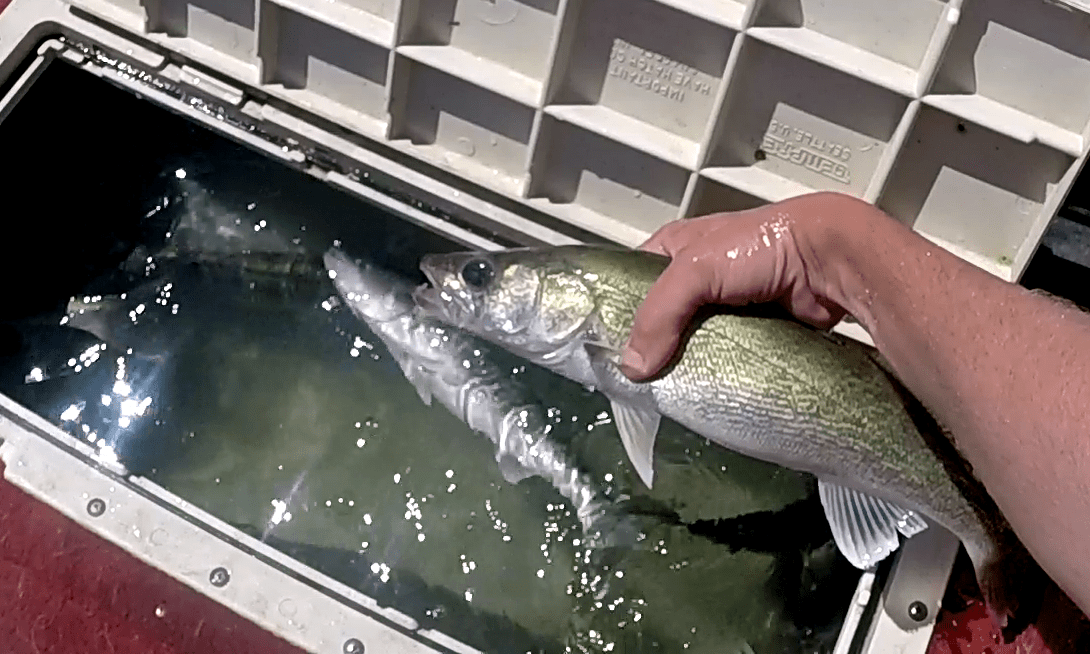
More advanced walleye fry will be stocked into North Dakota lakes this summer in an effort to see if the larger fish can survive opportunistic predators, and provide better fishing in the coming years. Simonson Photo.
By Nick Simonson
While much of the hustle and bustle of spring is wrapping up at the U.S. Fish & Wildlife Service’s Valley City Fish Hatchery, after a season full of rearing northern pike and walleye eggs to stockable fry to be distributed throughout the upper Midwest, an expanding project is underway to see if walleyes reared to a larger size will make for better stocking efforts. So as the last of the standard one to one-and-a-half inch walleyes prepare to be transported off the property, a new batch of those same fish will be coming back to the ponds at the facility, according to Aaron Von Eschen, who manages the hatchery.
“It’s going to be a pretty busy summer, we’re trying something pretty new to the facility this year, in that after this first round of walleye are done, we’re going to refill all the ponds and stock walleye back into them to try and raise them to a larger size for the state of North Dakota,” Von Eschen says, “our target size for those fish is four inches, and we’re anticipating it is going to take about a month to a month-and-a-half,” he adds.
The idea is to raise walleyes to a larger size to help them take better to waters where more predators may be present, and more opportunistic fish, such as bullheads, often impact the stocked populations of standard fry that are added to lakes. The hope, as a result, is for a better fishery and a greater percentage of walleyes surviving their first year in the water. As it turns out, the extra investment of time and energy isn’t a large cost to the North Dakota Game & Fish Department (NDG&F) to raise these fish to a larger size, according to Jerry Weigel, Fisheries Production & Development Section Leader for the NDG&F, as less of them need to be stocked to have a similar impact on populations as standard fry.
“They have a minimal impact from a production standpoint as we simply stock back a reduced number in production ponds and allow the fingerlings to grow another two months on natural food, so cost only slightly higher,” Weigel explains, “we stock a much-reduced number per acre versus if the lake had received standard fingerlings, so again, very little increase in costs with the larger fish,” he adds.
Piggybacking on last year’s stocking of approximately 170,000 advanced walleye fingerlings throughout the state, the agency plans on releasing around 235,000 of them this year. The lakes targeted for the project include waters which have a higher population of bullheads, a primary predator for standard-sized walleye fry. In 2021, the NDG&F will stock advanced walleye fingerlings into the following lakes: Epping and Springbrook in Williams County, Cedar Lake in Slope County, Boundary, Long, Loon and Metigoshe in Bottineau County, Braun in Logan County, South Golden in Steele County, Wood in Benson County, Ashtabula in Barnes County and Lake Lamoure in Lamoure County.
Due to the fish being approximately four times the length of standard fry, increased weight and volume of the total stocking efforts have to be considered, and Weigel explains that increased transportation efforts are the biggest factor, as the fish weigh 10 to 15 times more than the standard-sized fry. With the program only recently begun in North Dakota, the agency is keeping close tabs on how well the advanced fry do in comparison after stocking during their annual fish surveys, and as of right now, results are variable with more years needed to reach a consensus as to its benefit. Over time however, the determination will be made as to whether or not these new efforts with the advanced fry are worth it, when compared with the millions of standard fry that are stocked across the Peace Garden State each spring and summer.
“We have an extremely efficient system with great success with our standard one-and-a-half-inch fingerlings; we have a good standard established to measure against,” Weigel comments on the control populations in place, “even with the minimal cost increase, they will have to outperform the standard fingerlings to become part of standard management strategy,” he concludes.
